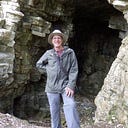Why There Are No Wholes in Nature -
Dynamic Boundaries; Continuous Space
***What is an Individual?***
That was the research question that ultimately led me to question everything I’d been told by conventional analytical science in general and evolutionary biology in particular. Because it has no definitive answer. As William Wordsworth put it:- ‘In nature, everything is distinct, yet nothing defined into absolute, independent singleness’.
The very idea that reality can be subdivided or aggregated into discrete numerical units that can be treated as independent ‘wholes’ acted upon by external ‘force’ is inconsistent with evidence and incapable of making consistent natural sense. It is an abstraction from nature, not a truthful representation of nature. And while it can be useful in the short term for certain navigational purposes, it is capable of causing great psychological, social and environmental harm.
The assumption of definitive completeness, which underlies modern analytical science and artificial intelligence is simply false. Nature is intrinsically fluid, not digital. There is no definitive separation and
***There are no wholes in Nature***
Not even one.
There are only dynamically distinct localities in place-time. And the reason for this is simple. Natural space is continuous. Natural boundaries are dynamically informed.
Material bodies, from sub-atomic scale outwards are flow-forms — co-creations of space and energy in receptive-responsive relationship. Every body dwells within every other body’s receptive-responsive gravitational and energetic influence. Natural boundaries are intrinsically dynamic distinctions between inner and outer space, not rigid partitions. Natural space is an infinite, intangible, continuum, not a 3-dimensional box. Evolution occurs in response to receptive influence, natural inclusion, not selective external force.
Try asking yourself, ‘what is an individual?’. Then take a look around yourself. Do you see a world of isolated objects? Or a single isolated object? If not, why not?
For further exploration of the meaning and scientific, social, psychological and environmental implications of natural inclusion, please visit http://www.spanglefish.com’exploringnaturalinclusion.
